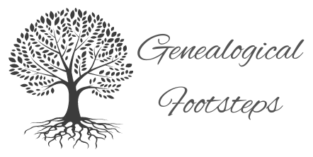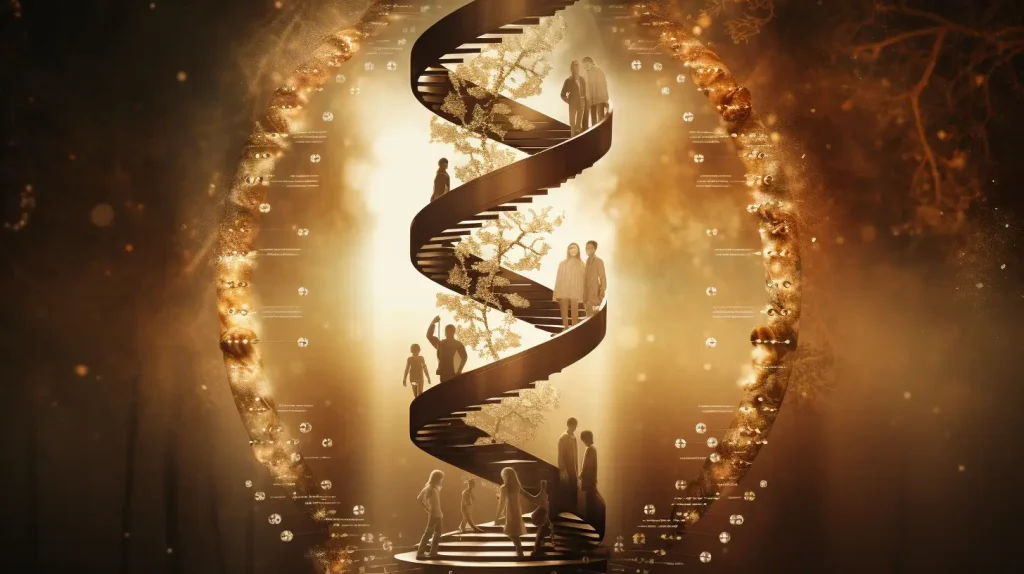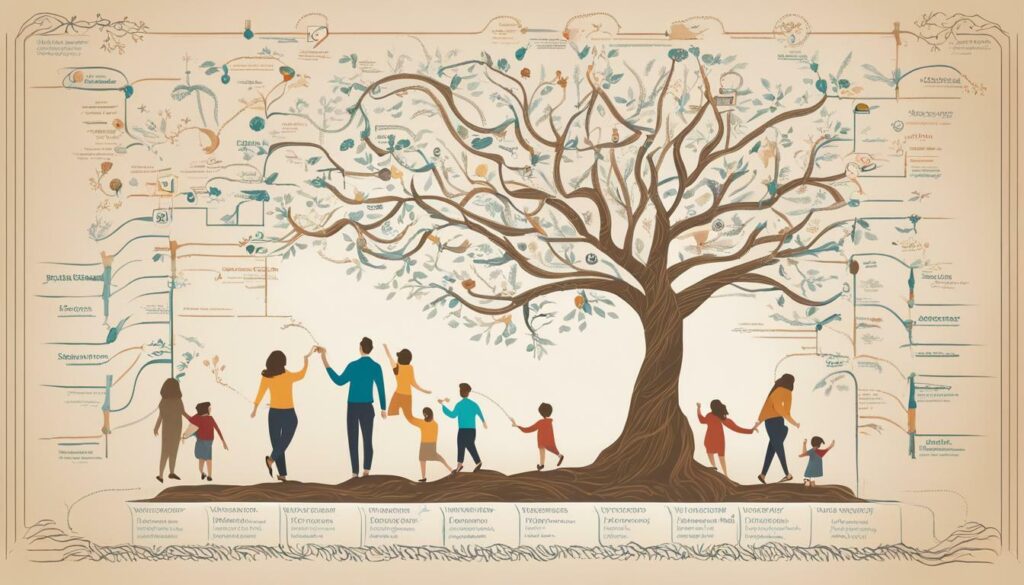Genetic matches interpretation is a complex process that can provide valuable insights into one’s genetic makeup and ancestry. However, it can be an overwhelming experience for many individuals who are not familiar with the science behind it. This comprehensive guide will help readers understand genetic matches interpretation and provide guidance on how to make sense of their DNA results.
Key Takeaways:
- Understanding genetic matches is essential for insights into genetic makeup and ancestry.
- Interpreting genetic matches requires specialised knowledge in genetic data analysis.
- The process involves sophisticated comparisons of an individual’s DNA with a reference database.
- Factors like match quality, shared DNA degree, and known genealogical connections are crucial.
- Using heatmaps and other tools helps trace migration patterns and shared ancestry.
- Engaging with online databases and DNA comparisons can reveal extensive family history and ancestry.
- Issues of privacy, consent, and responsible use of genetic information are paramount.
Understanding Genetic Matches
Genetic matches are identified through genetic testing, which analyses specific regions of an individual’s DNA. This type of testing is becoming increasingly popular, allowing individuals to gain insights into their ancestry and genetic makeup. Nevertheless, interpreting genetic testing results can be challenging, and understanding genetic matches is crucial for accurate analysis.
Indeed, interpreting genetic testing results requires an understanding of the genetic matching algorithm, which uses complex calculations to determine DNA matches. Once identified, genetic matches provide valuable information about an individual’s genetic ancestry and can be utilised in various ways.
Genetic match analysis involves assessing and interpreting the results of genetic testing. This process includes identifying and analysing genetic matches, determining the significance of specific matches, and tracing the ancestral roots of an individual.
Genetic Matching Algorithm
The genetic matching algorithm used to determine DNA matches is a complex and sophisticated process that requires an in-depth understanding of genetic data interpretation. It involves comparing an individual’s DNA with a reference database of genetic information to identify matching segments.
The matching algorithm considers several factors, including the length and location of the matching segments, the number of shared variants, and the frequency of those variants in the population. This information is used to calculate a genetic distance measure, which indicates the degree of relatedness between the individuals.
Genetic data interpretation plays a critical role in the accuracy and reliability of the matching algorithm. It involves analysing and interpreting the raw genetic data generated from the DNA test to identify specific genetic variations, or single nucleotide polymorphisms (SNPs), that are associated with particular ancestral populations.
The accuracy of the genetic matching algorithm and the reliability of the DNA test results are dependent on the quality and quantity of the reference database used. The larger and more diverse the reference database, the more accurate and informative the genetic matches will be.

Interpreting DNA Matches
Interpreting DNA matches is a crucial aspect of genetic testing, as it can provide valuable insights into an individual’s genetic ancestry. To properly interpret genetic matches, several factors must be taken into consideration: the number and quality of matches, the degree of shared DNA, and the presence of any known genealogical connections.
One important aspect of genetic ancestry interpretation is identifying the geographic origins of an individual’s ancestors. By analysing genetic matches with individuals from different regions, it may be possible to trace the various migration patterns that shaped a person’s genetic makeup.
It is also important to understand the limitations of genetic testing and the degree of certainty that can be attributed to any conclusions drawn from DNA matches. Genetic testing can provide insight into ancestry going back several generations, but it cannot conclusively determine an individual’s ethnicity or heritage.
Deciphering DNA Match Results
When deciphering DNA match results, it is important to take into account the size of the shared DNA segments. A larger shared segment generally indicates a closer genetic relationship, while smaller segments may indicate more distant connections.
Another factor to consider is the total number of shared DNA segments. A larger number of shared segments may indicate a more recent common ancestor, while a smaller number may suggest a more distant connection.
It’s important to investigate any known genealogical connections with genetic matches, such as shared surnames or geographic origins. This information can help confirm or refute hypotheses about the relationships between individuals and their genetic matches.
Ancestral Mapping with DNA Matches
Ancestral mapping is a powerful tool that can be used to trace the migration patterns of one’s ancestors. By analysing genetic matches with individuals from different regions, it is possible to identify where specific ancestors may have originated or migrated to over time.
One common ancestral mapping technique is to use a heatmap, which visually represents the frequency and density of genetic matches across different regions. This can help identify clusters of shared ancestry and provide insights into the migration patterns of an individual’s ancestors.
Interpreting DNA matches and analysing genetic ancestry can provide valuable insights into a person’s genetic makeup and ancestral roots. By taking into account the various factors involved in genetic matches interpretation, individuals can gain a deeper understanding of their heritage and ancestry.

Exploring Genetic Heritage
Exploring genetic heritage is an essential aspect of genetic ancestry interpretation, providing individuals with the opportunity to trace their ancestral roots and gain a deeper understanding of their genetic makeup.
One way to explore genetic heritage is through the analysis of DNA matches. By comparing DNA test results with others in the genealogy community, individuals can identify potential ancestors, uncover family connections, and potentially discover new branches of their family tree.
Another approach to exploring genetic heritage is through the analysis of haplogroups. Haplogroups are genetic populations that share a common ancestor, often dating back thousands of years. By identifying one’s haplogroup, individuals can gain insights into their deep ancestry and migration patterns of their ancestors.
Genetic heritage can also be explored through the analysis of admixture results, which provide information on the ethnic and geographical origins of an individual’s ancestors. Admixture analysis can help to identify where ancestors lived and potentially reveal previously unknown relationships.
Utilising Genetic Matches for Research
Genetic matches interpretation is not only useful for discovering more about one’s own genetic makeup, but it can also be a valuable tool for research. Through genetic testing, individuals can connect with others who share their DNA and uncover new information about their family history and ancestry.
One way to utilise genetic matches for research is to participate in online databases such as AncestryDNA and 23andMe. These databases allow individuals to connect with genetic matches and build a family tree based on shared DNA. This can lead to the discovery of unknown relatives and ancestors, and provide a wealth of information for further research.
Another way to utilise genetic matches for research is to compare DNA with others who have already conducted genealogical research. By doing so, individuals can confirm or refute family connections and uncover new information about their family history.
Researching genetic matches can also shed light on cultural and geographic origins. By examining shared DNA with people from a particular region or cultural group, individuals may gain insight into their own ancestry and heritage.
It is important to note that caution should be exercised when conducting research with genetic matches. Personal privacy and informed consent should always be prioritised. It is also important to consider the accuracy and limitations of genetic testing, as well as the potential impact of uncovering unexpected familial relationships.

Advanced Techniques in Genetic Matches Interpretation
While basic genetic matching analysis can provide valuable insights into ancestry and family history, advanced techniques can take interpretation to the next level. By utilising additional tools and resources, individuals can gain deeper insights into their genetic makeup and ancestry.
Phasing
One advanced technique in genetic matching analysis is phasing. This involves identifying which DNA segments were inherited from each parent, allowing for a more accurate analysis of genetic matches. Phasing can provide a clearer picture of an individual’s ancestral roots and help to identify specific regions or populations that their DNA is linked to.
Triangulation
Another advanced technique is triangulation. This involves comparing the DNA of multiple individuals to identify common segments of shared ancestry. By triangulating DNA matches, individuals can pinpoint specific ancestors or geographic locations that their DNA is linked to. Triangulation can also be useful for verifying genetic matches and ruling out false positives.
Chromosome Mapping
Chromosome mapping is another advanced technique that can provide valuable insights into genetic matches. This involves identifying which chromosome segments are linked to specific ancestors or ethnic groups. By mapping out their chromosomes, individuals can gain a more detailed understanding of their genetic makeup and ancestry.
Third-Party Tools
In addition to these techniques, there are a variety of third-party tools and resources available that can assist in genetic matching analysis. These tools can provide additional insights into genetic matches and help to identify specific ancestors or populations that an individual’s DNA is linked to. However, it is important to use caution when utilising third-party tools and to carefully evaluate the accuracy and reliability of their results.
| Technique | Description | Applications | Common Third-Party Tools |
|---|---|---|---|
| Phasing | Involves differentiating which DNA segments were inherited from each parent. | Provides a clearer understanding of ancestral roots. Helps in identifying specific regions or populations. | GEDmatch FamilyTreeDNA’s Family Finder |
| Triangulation | Comparing the DNA of multiple individuals to find shared ancestry segments. | Pinpoints specific ancestors or locations. Useful in verifying genetic matches and ruling out false positives. | DNA Painter MyHeritage DNA |
| Chromosome Mapping | Identifies chromosome segments linked to specific ancestors or ethnic groups. | Offers detailed insights into genetic makeup and ancestry Can trace lineage to particular ancestors or groups. | 23andMe’s Ancestry Composition AncestryDNA’s Ethnicity Estimate |
| Third-Party Tools | Various tools and resources available outside primary DNA testing services. | Provide additional insights into genetic matches Help identify specific ancestors or populations. | Promethease Genetic Affairs |
Note: While third-party tools can enhance understanding, it’s important to consider their accuracy and reliability. Privacy concerns should also be taken into account when using these tools.
Ethical Considerations in Genetic Matches Interpretation
As genetic testing becomes more popular, the interpretation of genetic matches raises ethical concerns. There are several ethical considerations to bear in mind when analysing genetic matches.
Privacy Concerns
Sharing genetic information can be a sensitive matter, and there is a risk that this information may fall into the wrong hands. It is essential to consider the privacy risks when interpreting genetic matches. Individuals should be aware of who has access to their genetic test results and what those results reveal about their health, ancestry, and other personal information. It is crucial to choose a reputable genetic testing provider that follows strict privacy policies and takes measures to safeguard client data.
Consent Issues
Obtaining informed consent from individuals before conducting genetic testing is essential. People have the right to know what the testing entails, what the results will reveal, and how the information will be used. It is vital to ensure that individuals fully understand the implications of genetic testing before consenting to it.
Responsible Use of Genetic Test Results
Genetic testing results can provide valuable information, but it is crucial to use this information wisely and responsibly. It is inappropriate to use genetic testing results to discriminate against individuals based on their health status or genetic makeup. Furthermore, individuals should be aware of the limitations of genetic testing and avoid making hasty decisions based solely on the results.
Challenges and Limitations in Genetic Matches Interpretation
While DNA testing provides a wealth of information about an individual’s genetic makeup, there are several challenges and limitations that may arise when interpreting genetic matches.
One significant challenge is the amount of genetic data available and its complexity. Interpreting genetic testing results requires a thorough understanding of genetic inheritance, genealogy, and statistical analysis. This can be difficult for individuals who lack a background in these areas.
Another limitation is the potential for false positives or false negatives. While genetic matching algorithms are highly accurate, errors can occur due to sample contamination, technical issues, or other factors.
Privacy concerns are also a major issue when interpreting genetic matches. Individuals may be hesitant to share their genetic data with third-party companies or researchers due to fears of genetic discrimination or misuse of their data.
Finally, there is the risk of misinterpretation or over-interpretation of results. Genetic testing can provide valuable insights into an individual’s ancestry and genetic predispositions, but it should be used in conjunction with other sources of information and should not be relied upon as the sole indicator of identity or health.
Addressing Challenges and Limitations
Despite these challenges and limitations, there are ways to navigate them and still gain valuable insights from genetic testing results. It is important to work with a reputable genetic testing company that follows ethical standards and provides accurate and detailed information about the testing process and results.
It is also helpful to seek out additional resources and education on genetic testing and interpretation. Many companies and organisations offer educational materials and resources to help individuals understand their genetic matches and interpret their results accurately.
Lastly, it is important to approach genetic testing with a critical eye and to seek out multiple sources of information when interpreting results. By doing so, individuals can gain a deeper understanding of their genetic makeup and ancestry while navigating the challenges and limitations of genetic matches interpretation.
Below is a table that encapsulates the main points, and I’ve also added additional considerations based on the context of genealogical research and interpretation:
| Challenges and Limitations in Genetic Matches Interpretation | Suggested Approaches to Address Challenges |
|---|---|
| Complexity of Genetic Data – Requires understanding of genetic inheritance, genealogy, and statistical analysis. | Education and Resources – Utilise educational materials from reputable companies and organisations. |
| Potential for False Positives/Negatives – Errors can occur due to sample contamination or technical issues. | Quality Testing – Use reputable genetic testing services with high accuracy standards. |
| Privacy Concerns – Fears of genetic discrimination or data misuse. | Ethical Standards – Choose companies adhering to ethical guidelines and ensuring data privacy. |
| Risk of Misinterpretation – Over-reliance on genetic testing for identity or health insights. | Critical Analysis – Cross-reference genetic data with other sources of information. |
| Historical Context Limitations – Genetic data may not fully account for complex historical migrations and social structures. | Contextual Analysis – Integrate historical and social context in interpreting genetic data. |
| Cultural Considerations – Genetic interpretations might overlook cultural and ethnic nuances. | Cultural Sensitivity – Incorporate cultural understanding in the analysis of genetic data. |
This table not only addresses the initial concerns but also integrates additional aspects that are particularly relevant from a genealogical and historical standpoint. It’s crucial to recognise that genetic data interpretation, especially in the context of family history and genealogy, requires a multidimensional approach considering both scientific and socio-historical factors.
To Conclude
Making sense of DNA genetic matches can be a daunting task, but it is one that is well worth the effort. Understanding genetic matches provides invaluable insights into one’s ancestry and genetic makeup, which can have significant implications for health, research, and personal identity.
Through this comprehensive guide, readers have learned the importance of interpreting genetic testing results and gained insights into the analysis of genetic matches. We explored the genetic matching algorithm used to determine DNA matches, deciphered and analysed DNA match results, and discovered how to trace ancestral roots for a deeper understanding of genetic heritage.
Advanced techniques in genetic matches interpretation and ethical considerations that arise when interpreting genetic matches were also discussed. In addition, the challenges and limitations that individuals may encounter when interpreting genetic matches were identified and explored.
Overall, understanding genetic matches is a crucial step towards unlocking one’s genetic story. By taking the time to explore and interpret DNA results, individuals can gain a newfound appreciation for their ancestry and better understand the role genetics play in their lives.
So, whether you are just getting started or are well-versed in the world of genetic matches interpretation, keep exploring, keep learning, and keep discovering the secrets hidden in your DNA.
FAQs
Q: What are genetic matches and why are they important? A: Genetic matches are identified through DNA testing, analysing specific regions of an individual’s DNA. They are crucial for gaining insights into one’s genetic makeup and ancestry, helping to trace ancestral roots, uncover family history, and identify potential health risks.
Q: How is a genetic matching algorithm used in DNA testing? A: The genetic matching algorithm compares an individual’s DNA with a reference database to identify matching segments. It considers factors like the length and location of matching segments, shared variants, and their frequency in the population. This sophisticated process is essential for accurate DNA match results and understanding genetic heritage.
Q: What are the key steps in interpreting genetic data from DNA tests? A: Key steps include identifying single nucleotide polymorphisms (SNPs) associated with specific ancestral populations, determining their frequency in the reference population, and comparing an individual’s SNPs with the reference population to assess genetic ancestry.
Q: How do you interpret DNA matches and their significance? A: Interpreting DNA matches involves considering the number and quality of matches, the degree of shared DNA, and any known genealogical connections. It’s also important to understand the limitations of genetic testing in determining ethnicity or heritage.
Q: What techniques are used for advanced genetic matches interpretation? A: Advanced techniques include phasing (identifying DNA segments inherited from each parent), triangulation (comparing DNA of multiple individuals to identify common ancestry), and chromosome mapping (identifying chromosome segments linked to specific ancestors or ethnic groups).
Q: What are the ethical considerations in genetic matches interpretation? A: Ethical considerations include privacy concerns, ensuring informed consent for genetic testing, and the responsible use of genetic test results. It’s crucial to respect personal privacy and avoid misuse of genetic information.
Q: What challenges and limitations might one encounter in genetic matches interpretation? A: Challenges include the complexity of genetic data, potential for false positives or negatives, privacy concerns, and the risk of misinterpretation. It’s important to work with reputable testing companies and seek multiple sources of information for accurate interpretation.
A Poem From Me To You…
Threads of Inheritance In the spiral staircase of our being, so tight, Lie secrets woven in strands of light. DNA, our blueprint, a guide so clear, Maps our essence from far to near. In each cell, a story, an ancestral song, Telling of journeys, both short and long. Genetic matches, a mirror to the past, Revealing connections so very vast. A dance of chromosomes, a delicate embrace, Linking generations, race to race. In DNA's whispers, truths unfurl, The code of life, a precious pearl. So know these matches, read with care, In them, the tales of who, what, where. For in our genes, we find the key, To who we were, are, and will be.
COPYRIGHT NOTICE
Please be advised that all images, designs, and creative content on this page are the exclusive property of GenealogicalFootsteps.co.uk and are protected under international copyright laws. The images may not be reproduced, copied, transmitted or manipulated without the written permission of GenealogicalFootsteps.co.uk.
Unauthorised use, distribution, display, or creation of derivative works of any images contained on this page, is strictly prohibited and can lead to legal penalties. We actively monitor for, and enforce, our copyright interests. If you wish to use any of our images, kindly contact us to seek permission. Respect of copyright is not merely a legal requirement but also an acknowledgement and support of the hard work and creativity that goes into producing them.
Thank you for your understanding and cooperation.
© 2023, GenealogicalFootsteps.co.uk. All Rights Reserved.

My name is Anthony, the founder of Genealogical Footsteps. I have over 20 years of dedicated experience in family history and genealogy (although I am not a professional genealogist). I hold BA in history, and am considering further education (despite my age). My journey in genealogy has led me to remarkable discoveries and projects, particularly where my Cypriot genealogy is concerned. I am passionate about uncovering the stories behind names and have helped friends and family connect with their heritage, including those with Cypriot, Celtic, and Viking ancestry. Click here to read more about me.



